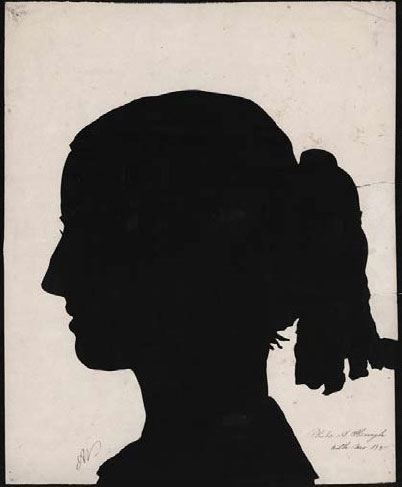- Relief printing
- Intaglio and planographic printing
- Color printing
- Bits and pieces
- Early photography in silver
- Non-silver processes
- Modern photography
- Color notes
- Color photography
- Photography in ink: relief and intaglio printing
- Photography in ink: planographic printing
- Digital processes
- Where do we go from here?
Silhouettes
 Silhouette. Anna Wharton. Phebe A. Hough. 1856. 12 1/2 x 12 5/16" (31.8 x 31.3 cm). The Museum of Modern Art, New York. Gift of Richard Benson.
Silhouette. Anna Wharton. Phebe A. Hough. 1856. 12 1/2 x 12 5/16" (31.8 x 31.3 cm). The Museum of Modern Art, New York. Gift of Richard Benson.
For much of the previous century, the cutting of silhouettes had been a pastime at parties and family gatherings. They were made through the use of light, by tracing the shadow of a person’s profile. The traditional way to do it was to have the subject sit with a book, or some like-shaped object, pressed between their head and the wall, and with a piece of paper between their head and the book. The book both supported the piece of paper and served the useful role of keeping the subject from moving. A candle across the room cast a shadow; this outline was traced, the paper was removed, and the silhouette was cut out from it with scissors. Multiple copies were often made so that everyone could take the pictures home with them as mementos. In viewing a silhouette, we are most often looking at negative space—not the positive figure but the white paper from which it has been cut, and which is set against a sheet of black paper.
Although this picture-making practice goes back into the eighteenth century, well before the invention of photography, the pictures it produced have always seemed to me as photographic as anything else: they record the actual form of the subject, and it is very easy to identify silhouettes of those one knows. In the eighteenth and nineteenth centuries, silhouettes of full-length figures were made, not based on the tracing of light but cut by eye. Similar silhouette-making is done today at carnivals and tourist destinations, with the maker usually just looking at the person to be depicted and then cutting a reduced-size silhouette directly. This method is closer to caricature than to photography, since the outline comes from an image in the maker’s mind, rather than being generated by some mechanical means from the subject itself.

